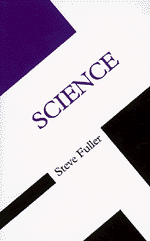

![]()
![]()

This book is a useful and insightful journey through some of the key debates about science as a human activity. It covers a great deal of ground: Fuller is concerned with science as a domain of economic activity, an epistemological system, a social institution and as a historical and cultural artifact. The broad sweep draws in - inter alia - discussions of the science citation index, the links between science and democracy, the development of science in Japanese and Islamic cultures and a historical comparison between Europe and China. For all of these topics, the author is candid about the difficulty of coming to simplistic conclusions, resisting the temptation to cast the sequence of ideas into a too-neat overarching framework. The book is a cascade of topics and concepts rather than a crafted linear argument, and in this way the form reflects the content. Although deeply concerned with both philosophy and history, Fuller is not attempting grand theory a la Popper or Kuhn. Instead, the objective seems to be to highlight from as many angles as possible the cultural and historical contingency of how science is practised and understood.
In such a brief book, the density of ideas becomes a little mind-boggling, and the discussion lurches around somewhat: in a couple of pages Fuller can take the reader from St Augustine to the Human Genome Project via Liebnitz, Voltaire, Herbert Spencer, Herbert Simon and Paul Feyerabend. Indeed, the constant name-checking of Great Men (usually accompanied by dates of birth and death) becomes a little tiresome in places: sometimes rather spurious allusions seem to squeeze out the opportunity to build a more digestible argument. Nevertheless, the extraordinary erudition that the author displays makes the book both stimulating and thought-provoking, and this more than compensates for any stylistic irritation.
The books key target is the view - seemingly held by many scientists - that Western Science is natural in the sense of being beyond social critique. Fuller's arguments are persuasive, and there is certainly a need for brief and accessible texts in this area. I wonder, though, whether the form chosen for the book will alienate those not already persuaded by its arguments: my suspicion is that it would be rather a difficult book for those who would most benefit from its insights - like undergraduate scientists and engineers, or policy makers - but who generally lack prior knowledge of the philosophy and history of science. Despite this, the book is a useful resource and a timely contribution.
Steve New
University of Oxford